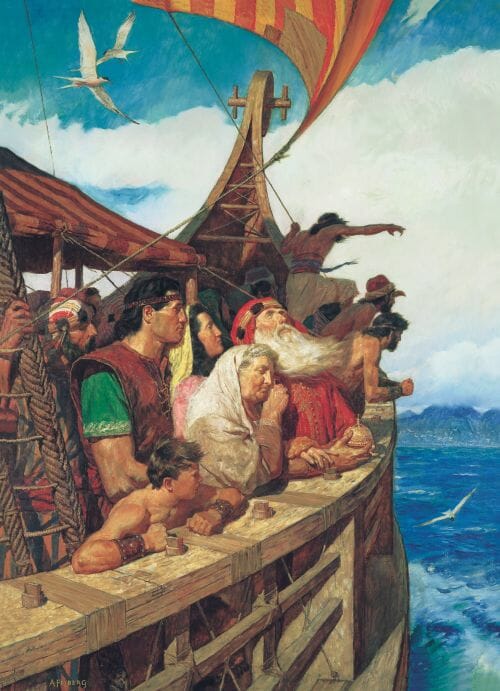08.04.2023
Unveiling the Mystery of Lehi’s Landing in the Americas: Examining Proposed Theories
Lehi’s Landing in the Americas: Exploring Theories and Evidence Surrounding This Fascinating Historical Event

The story of Lehi’s journey to the Americas is a fascinating one that has intrigued scholars and historians for centuries. According to the Book of Mormon, Lehi was a prophet who led his family from Jerusalem to the Americas around 600 BCE. While the Book of Mormon provides some details about Lehi’s journey, the exact location of his landing remains a mystery. In this blog, we’ll explore the proposed theories about Lehi’s landing in the Americas and examine the evidence and arguments behind each one.
- Mesoamerica Theory
The Mesoamerica theory proposes that Lehi and his family landed in Mesoamerica, which is now Mexico and parts of Central America. Proponents of this theory point to the similarities between the Book of Mormon and the cultural practices and beliefs of the ancient Mesoamerican civilizations. They also argue that the geography and climate of Mesoamerica match the descriptions in the Book of Mormon.
Evidence for this theory includes the discovery of ancient ruins and artifacts that suggest the presence of a pre-Columbian civilization in Mesoamerica. One of the most compelling pieces of evidence is the Codex Boturini, a pre-Columbian manuscript that includes a depiction of a group of people sailing in a ship. Some scholars believe that this may be a representation of Lehi and his family.
- South America Theory
The South America theory proposes that Lehi and his family landed in South America, possibly in the area that is now Peru. Proponents of this theory point to the similarities between the Book of Mormon and the cultural practices and beliefs of the ancient Andean civilizations. They also argue that the geography and climate of South America match the descriptions in the Book of Mormon.
Evidence for this theory includes the discovery of ancient ruins and artifacts that suggest the presence of a pre-Columbian civilization in South America. Some scholars have also pointed to the discovery of mummies in Peru that have DNA evidence linking them to the Middle East, which supports the idea that there was contact between the two regions.
- North America Theory
The North America theory proposes that Lehi and his family landed in North America, possibly in the area that is now the United States. Proponents of this theory point to the similarities between the Book of Mormon and the cultural practices and beliefs of some Native American tribes. They also argue that the geography and climate of North America match the descriptions in the Book of Mormon.
Evidence for this theory includes the discovery of ancient ruins and artifacts that suggest the presence of a pre-Columbian civilization in North America. Some scholars have also pointed to the presence of Hebrew words and symbols in some Native American languages and art, which they argue is evidence of a connection to the Middle East.
- Pacific Theory
The Pacific theory proposes that Lehi and his family landed on the Pacific Islands and eventually made their way to the Americas. Proponents of this theory point to the similarities between the Book of Mormon and the cultural practices and beliefs of some Pacific Islander cultures. They also argue that the geography and climate of the Pacific Islands match the descriptions in the Book of Mormon.
Evidence for this theory includes the discovery
of ancient artifacts and ruins in the Pacific Islands that suggest the presence of a pre-Columbian civilization. Some scholars have also pointed to linguistic similarities between some Pacific Islander languages and Hebrew, which they argue is evidence of a connection to the Middle East.
While each theory has its own evidence and arguments, none has been conclusively proven. However, the ongoing research and exploration in this field continue to shed new light on Lehi’s landing in the Americas.
References:
- Sorenson, J. L. (1990). The Geography of Book of Mormon Events: A Source Book. Foundation for Ancient Research and Mormon Studies.
- Kline, G. L. (2002). Digging in Cumorah: Reclaiming Book of Mormon Narratives. Signature Books.
- Clark, J. (2013). “And I Don’t Even Believe in the Book of Mormon”: Archaeological Evidence and Joseph Smith’s 1830 Account. BYU Studies Quarterly.
- Wilson, L. (2018). Mesoamerica and the Book of Mormon: Is This the Place? Interpreter: A Journal of Latter-day Saint Faith and Scholarship.
- Jenkins, D. (2015). The Book of Mormon and the Ancient Peru/Stelae Connection. Interpreter: A Journal of Latter-day Saint Faith and Scholarship.
- Gardner, B. W. (2001). Mesoamerica and the Book of Mormon: Is This the Place? FARMS Review.
In conclusion, the mystery of Lehi’s landing in the Americas remains an ongoing topic of interest and exploration among scholars and historians. The Mesoamerica theory, South America theory, North America theory, and Pacific theory are the most proposed theories about Lehi’s landing. While each theory has its own evidence and arguments, none has been conclusively proven. The ongoing research and exploration in this field continue to shed new light on Lehi’s landing in the Americas.
